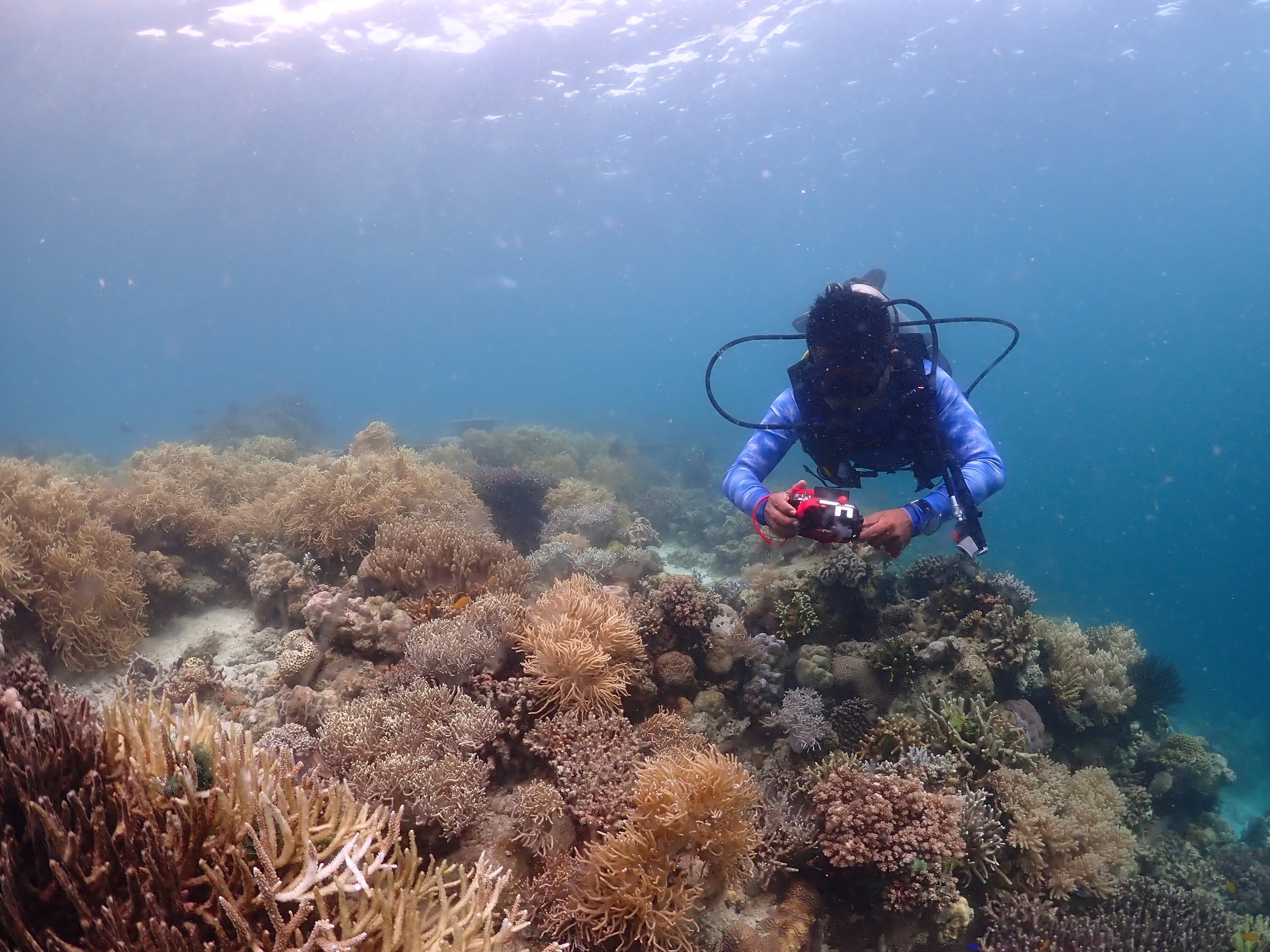kota kinabalu
“wanis” at sabah (sustainable development goals) SDG Conference
In January, the ‘Pertubuhan Wanita Kampung Song-Song’ (WANIS) attended the Sabah Sustainable Development Goals (SDG) Summit, where they presented their successful initiatives in empowering women within their village to enhance their quality of life. These efforts were acknowledged and appreciated by the Sabah Economic Development and Investment Authority (SEDIA), highlighting the organization's impactful contributions to sustainable development and women's empowerment in the region. WANIS has been actively empowering women of the village, equipping them with new skills that helps them with an alternative income, such as selling locally-made woven products (seen in the photo below).
WANIS representative, Kak Salina, at their booth for the Sabah SDG Conference
equipping stakeholders with new skills
In February, our colleagues from RCM conducted an Eco-Diver Training with the communities from Kg. Tajau Laut and Kg. Malubang, Kudat. Organized by Sabah Parks, this training aims to empower divers from the two villages to participate in reef conservation efforts and monitor the health of their marine ecosystems. We’ve conducted similar trainings for other local community members from other islands, and these representative were able to join us for activities such as reef rehabilitation and Reef Check surveys.
Besides the EcoDiver training, RCM also conducted a Coral Bleaching Monitoring Training with representatives from Sabah Parks as well as the Borneo Marine Research Institute (BMRI) from Universiti Malaysia Sabah. This training was held in response to the NOAA Coral Reef Watch Satellite Bleaching Alert. Sessions included a detailed look at bleaching as well as understanding of the coral bleaching watch protocol to consistently monitor affected coral reefs by the rising water temperature. Collaboration with organizations like Sabah Parks and the BMRI suggests a comprehensive approach involving research, conservation, and management of coral reef ecosystems in the region.
semporna
Mooring buoys to reduce anchor impact
In January, our colleagues in Semporna, together with representatives from Jeti Pelancong Semporna, the Semporna Professional Divers Association - SPDA, Semporna District Office, youth leaders from the Larapan Marine Conservation Groups, and Pulau Sipadan Resorts & Tours, deployed four mooring buoys in Timba-Timba Island.
These sites are famous tourist sites, who come over for snorkelling or diving. Recognising the possible damage caused by anchor impact, the installation was done promptly to solve the problem and to promote the use of mooring buoys in other sites too. Each of the buoys are able to accommodate 3 to 5 boats at a time, as they are supported by sinkers made from metal drums filled with cement.
Heavy duty rope to connect the metal drums and mooring buoy
Boats utilizing the mooring buoys instead of anchoring
reef rehabilitation demonstrating promising progress
Efforts to rehabilitate and restore reef areas in the waters of Semporna have been making quick strides, with the full support from the local communities. In Selakan Island, we deployed 215 reef stars in the second phase. To date, we’ve successfully deployed 500 reef stars with 7,575 coral fragments. Throughout this second phase, we had support and participation from 60 community members of Selakan Island, the Selakan Marine Conservation Group, Sabah Parks, and Reef Check Malaysia (RCM). At the end of the programme, we organised a closing and appreciation night for everyone who came together and played a part in the project.
Meanwhile, on Kulapuan Island, we installed two types of rehabilitation structures with help from representatives from Larapan Marine Conservation Group and Pemimpin Belia IKLIM Mabul. Five coral collection tables with 1,170 coral cookies and 161 bottle frames, each with a coral fragment were successfully deployed.
Not too long after these two projects, we installed some structures in a new site in Larapan Island. In this new reef rehabilitation sites, our team deployed 168 bottle reefs and affixed around 600 coral fragments on coral rope nurseries. All this was completed within the span of two days, along with conducting regular maintenance on existing rehabilitation sites.
Coral rope nurseries affixed with coral fragments
Community engagement on waste management
RCM’s staff, Fauzi, recently conducted an engagement session with the community on Larapan Island. This was done to discuss as well as update the progress and challenges of the waste management program run on the island. The turnout was encouraging with almost 70 members of the community present, including the ‘Ketua Kampung’ and the local Field Coordinator for the waste management program.
Fauzi also shared the progress of the coral restoration project on the island. Ten of the participating houses in the waste management program were awarded with a ‘Certificate of Excellence’ for their full participation and compliance throughout 2023. We hope that this will encourage more households to actively participate in the program this year.
mantanani island
Education and Awareness Programmes
Along with all our conservation efforts with local communities, we’re also running continuous education programmes with the local schools on the islands we work on. In January, our colleague in Mantanani organised a snorkeling activity for 20 students and 3 teachers from SK Pulau Mantanani. During the activity, the students were able to see some coral reefs and marine life. These sightings were brought up during the review session at the end of the activity, where a brief background on coral reef ecosystem was also discussed.
As a follow up to the snorkeling activity, we had a classroom session on “The Ocean and Its Importances” with 45 students from Year 4-6 of SK Pulau Mantanani. During the session, we highlighted the importance of the ocean, the threats it faces and what we can do to help protect the ocean.
waste management continues to receive support
Since its introduction about 3 years ago, the local islanders of Mantanani have been exposed to waste management and its benefits. Recently, our colleague on the island organised a community engagement session focusing on waste management, attended by close to 100 islanders. We discussed the challenges faced by the efforts, and also updated them regarding the current status and progress of the waste management programme. We also took the opportunity to award 80 households with a “Certificate of Excellence” for their full participation and compliance with the programme throughout 2023.
In an effort to extend the programme, our local waste management team on the island embarked on a trial to compost daily collected waste. On the first day of the trial, the team successfully processed more than 80kg of food waste which will be composted. This extension was tested in a bid to reduce the amount of food waste that is collected by the local team every day. We hope that in the near future, composting will be a regular activity adopted by the local community.
